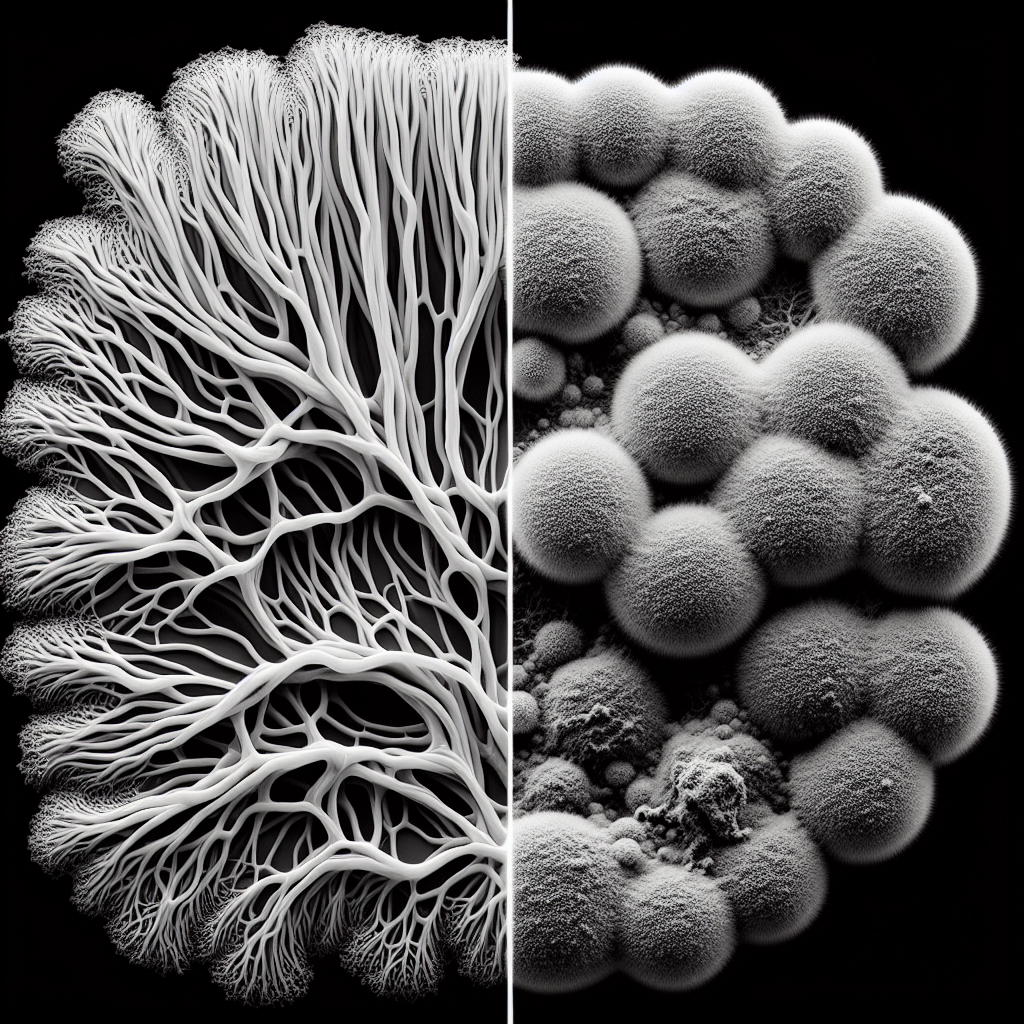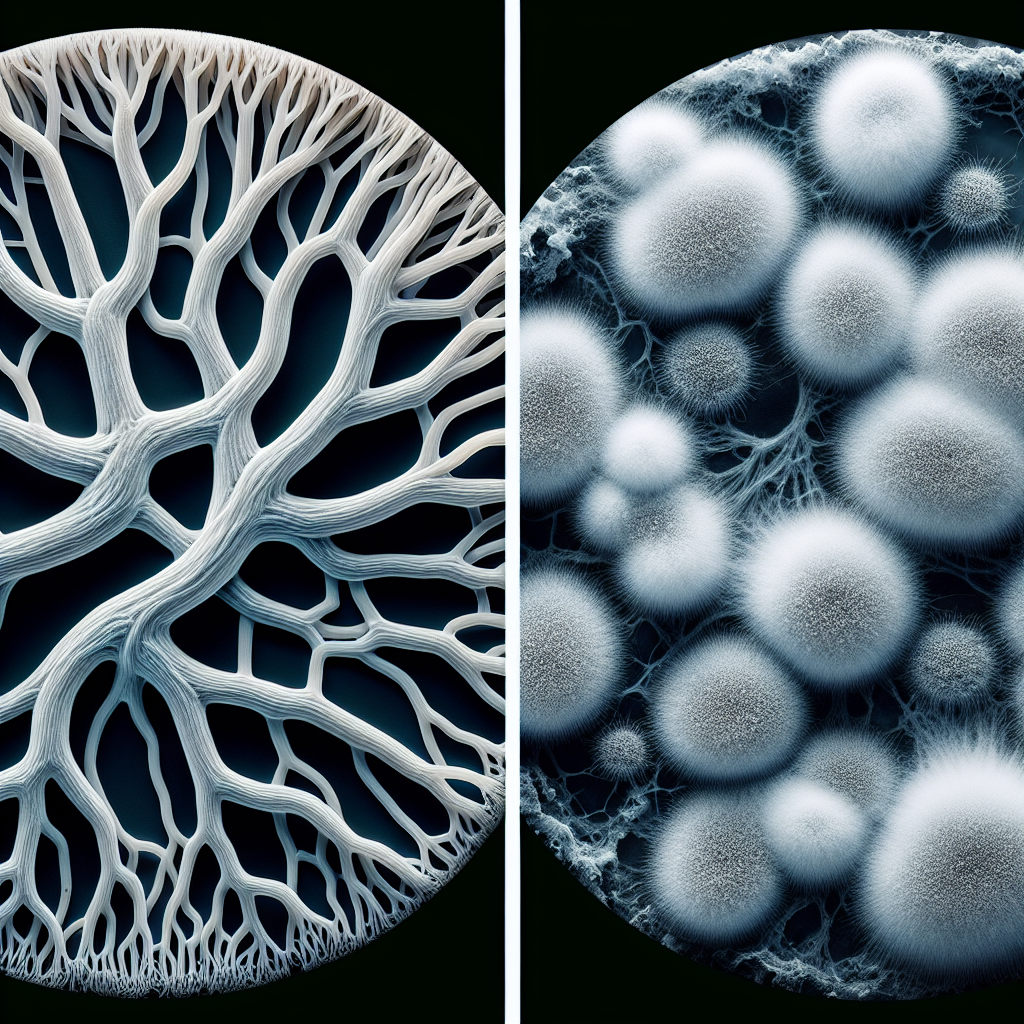In the world of fungi, Mycelium and Mold oftentimes become subjects of comparison, given their shared ecosystem and similar biological structures. “Comparative Analysis: Mycelium versus Mold” meticulously dissects these two fascinating organisms, assessing their characteristics, ecological influences, and the potential risks or benefits they pose. This article ensures you are armed with the necessary knowledge to navigate the fascinating, if not slightly mysterious, world that is fungi biology. Various dimensions of both Mycelium and Mold are explored to present a balanced and profound understanding of where they intersect and where they diverge in nature’s grand tapestry. This comparison may provide crucial insights into biological diversity while challenging certain misconceptions you may hold. Get ready to tread on a path that is seldom walked upon in scientific conversations.

Understanding Mycelium
Definition and Characteristics of Mycelium
Mycelium is a vast network of microscopic, thread-like structures, known as hyphae, which form the vegetative part of a fungus. It is a multi-cellular organism, primarily composed of strong and flexible fungal filaments. These hyphae, apart from being branched, are also tubular and can rapidly grow and elongate at their tips, thereby increasing in mass and size. Mycelium is instrumental in the absorption of nutrients from the substrate in which it is growing, and it can span large areas underground, albeit invisibly.
Key Functions of Mycelium
Mycelium plays pivotal roles in driving various ecological processes. Its prime function is the breakdown and recycling of organic material, returning the resulting compounds to the environment for use by other organisms. The mycelial network also supports the symbiotic relationship between fungi and plants known as mycorrhizal association. Here, mycelium aids the plant in absorbing nutrients while receiving sugars and other organic compounds from the plant in return.
The Role of Mycelium in Ecosystems
Mycelium plays a critical role in nutrient cycling and improving soil structure. Its mycorrhizal associations with plants boost plant health and resilience. The vast mycelial networks also function as a sort of communication framework known as the ‘wood wide web’. They enable the exchange of nutrients and information between different plants and play a role in community dynamics of plants and microbes in the ecosystem.
Different Species of Mycelium
Mycelium occurs in countless species of fungi. Examples include the mycelium of various mushroom-producing fungi like Agaricus bisporus which give rise to white button mushrooms, or Pleurotus ostreatus for oyster mushrooms. Other types, like the mycelium of Armillaria species, form a honey mushroom and are known for causing root diseases in plants.
Understanding Mold
Definition and Characteristics of Mold
Molds are a diverse group of fungal species characterized by the presence of long hyphae that form visible mycelium. They are multicellular and usually appear fuzzy or powdery, thanks to the production of spores on conidiophores, distinct reproductive structures. Molds show a typical growth pattern, appearing as circular colonies with varying colors such as green or black.
Key Functions of Mold
Molds are decomposers in the habitat they reside in. They break down various types of organic matter, including food, dead plants, and other decaying matter, into simpler chemicals. This decomposition helps recycle nutrients back into the ecosystem. Some molds also play a role in biodegradation and can help break down complex pollutants in the environment.
The Role of Mold in Ecosystems
Molds, with their saprophytic nature, are vital contributors to nutrient cycling in ecosystems. As decomposers, molds transform complex organic material into simpler forms that other organisms can utilize. Molds also serve as food for various arthropods, thus, playing a significant role in the food web.
Different Types of Mold
Mold types are vast, with over 100,000 different kinds. Examples include Aspergillus, a common type of mold found indoors that can cause respiratory infections in immunocompromised individuals. There’s Rhizopus, often found on stale bread and fruit, and Penicillium, the mold that gave us the antibiotic penicillin.
Structural Differences Between Mycelium and Mold
Morphological Structures of Mycelium and Mold
Mycelium and mold, although both are examples of fungal growth, have structural differences. Mycelium, in its form, is not visible to the naked eye unless it’s colonized sufficiently to form a fungal mat or a fruiting body like a mushroom. Mold, in contrast, is visible as fuzzy or powdery growth on the substrate—it grows as circular colonies that expand over time.
Cellular Structure and Composition
While both mycelium and mold consist of hyphae, these can differ structurally and functionally. Most mycelial cells are dikaryotic, having two genetically different nuclei, and are enclosed within a tubular cell wall composed of chitin. Mold cells, though also composed of chitin, often exhibit extensive septation (internal division walls), and may contain multiple haploid nuclei.
Growth and Proliferation
Growth Process and Conditions for Mycelium
Mycelium grows from germinated spores or from the extension of existing hyphae. Optimal growing conditions for mycelium include a stable environment, with an appropriate temperature (generally between 20°C and 30°C), sufficient moisture, and a substrate rich in organic matter. Upon reaching a certain mass, mycelium can produce mushrooms or other reproductive structures.
Growth Process and Conditions for Mold
Molds also develop from spores, which land on a suitable substrate and begin to grow hyphae. Molds prefer warmer temperatures, typically those common in indoor settings, and they require a moist environment. Furthermore, they need an organic food source such as bread, cheese, or damp wall materials.
Reproduction of Mycelium and Mold
Mycelia can reproduce asexually by fragmentation, releasing spores that establish new mycelial colonies, or sexually by fusing hyphae. Molds usually reproduce through spores, often in vast numbers, which disperse widely and lead to new colonies if conditions are favorable.

Mycelium and Mold in Biotechnology
Mycelium in Food Production and Agriculture
The applications of mycelium in biotechnology are diverse. Different species of mycelium, like those forming mushrooms, are cultivated en masse for human consumption. In agriculture, mycorrhizal fungi are incorporated into soils to augment plant nutrient uptake and boost soil health.
Mold in Food Industry and Bioconversion
Molds have various applications in the food industry. Blue cheese, for instance, owes its distinctive flavor and appearance to the mold Penicillium roqueforti. In Japanese cuisine, Aspergillus oryzae is used for producing fermented foods like soy sauce and sake. Molds also participate in bioconversion processes, converting wastes into valuable products.
Ecological Impact of Mycelium and Mold
Role of Mycelium in Soil Fertility and Cycle of Nutrients
Through decomposition of organic matter and mutualistic relationships with plants, mycelial networks significantly contribute to nutrient cycling and thereby soil fertility. They break down complex nutrients into simpler forms that can be absorbed by plants and other organisms.
Role of Mold in Decomposition Process and Nutrient Cycling
Molds are effective decomposers. They secrete enzymes that break down organic material into simpler substances, facilitating nutrient cycling in the ecosystem. Molds also aid in biodegradation and are capable of breaking down a variety of pollutants.
Negative Impacts of Mycelium and Mold on Ecosystems
In spite of their ecological roles, both mycelium and mold can have detrimental effects. Some species of mycelium, such as Armillaria, can cause diseases in plants. Molds, in turn, can create unhealthy conditions indoors when they overgrow and release spores in large numbers.
Health Implications of Mycelium and Mold
Potential Health Risks Related to Mycelium
While it’s rare for mycelium to pose a health risk, some types do produce toxic metabolites under certain conditions. Plus, improper handling of certain mushroom species leading to accidental ingestion or inhalation can potentially cause allergic reactions.
Health Concerns Associated with Mold Exposure
Exposure to molds can have significant health implications, notably when molds grow indoors. Inhalation of spores can cause allergic reactions, asthma exacerbations, and sometimes severe respiratory infections, particularly in those with compromised immune systems.
Management and Control of Mycelium and Mold
Control Measures for Mycelium in Agriculture
In managing mycelium, the goal is to encourage beneficial types and suppress harmful ones. Practices include using resistant plant varieties, monitoring moisture levels, and introducing beneficial fungal cultures that out-compete pathogenic ones.
Preventing and Controlling Mold Growth in Buildings and Indoors
Preventing mold growth indoors revolves around reducing moisture levels via dehumidification, adequate ventilation, and prompt repair of leaks. Once molds have established, they should be removed professionally to avoid spread and exposure to spores.
Mycelium and Mold in Cultural Context
Role of Mycelium in Traditional Medicines and Foods
Mycelium and the mushrooms they produce have long been used in traditional medicines, particularly in Asian cultures. They are prized for their medicinal properties such as immune modulation and anti-cancer effects. Certain kinds of mycelium are also consumed as food worldwide.
Cultural and Historical Significance of Mold
Molds have significant cultural and historical relevance. Penicillium is famously known for producing penicillin, the world’s first antibiotic. Some molds used in food production have been integral to different cultural cuisines, like blue cheese in Western Europe, or soybean fermentation in East Asia.
Summary: Key Similarities and Differences between Mycelium and Mold
Comparison of Structure and Functionality
While both mycelium and mold are products of fungal growth and have similar decomposing functions, they differ in their visible structure, cell composition, and some roles within their ecosystems. Mycelium is typically invisible without magnification and form extensive underground networks, while molds grow in visible colonies.
Contrasting Roles in Nature and Society
Both mycelium and mold are crucial for natural nutrient cycling and soil fertility. However, their societal roles diverge. Mycelium contributes significantly to agriculture and food production, while mold has a variety of uses in food and industry yet can pose significant health and building integrity concerns if found indoors.
Implications for Human Health and Environment
While both mycelium and mold can contribute positively to human wellbeing via biotechnological applications, they each present their own health risks. Mold exposure, in particular, can have serious health implications, particularly for individuals with existing respiratory or immunological conditions. Mycelium of certain species can produce toxins under some circumstances and improper handling of certain types of mushrooms, may lead to allergic reactions. Both mycelium and mold have an environmental impact, affecting soil fertility, plant health, and indoor built environments.
In conclusion, it’s clear that both mycelium and mold play essential, sometimes overlapping, roles in our ecosystems. Their differences – and the unique challenges and benefits they bring – allow us to appreciate the vast complexity of the fungal kingdom and its impact on our world.
